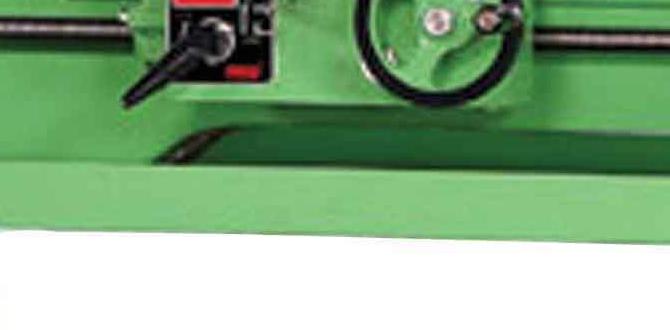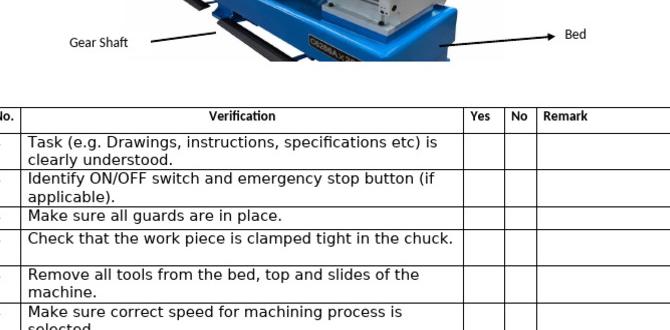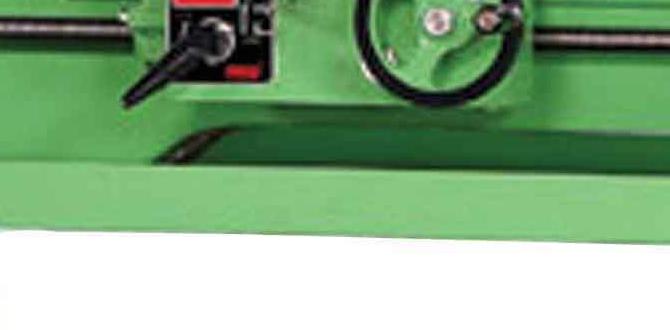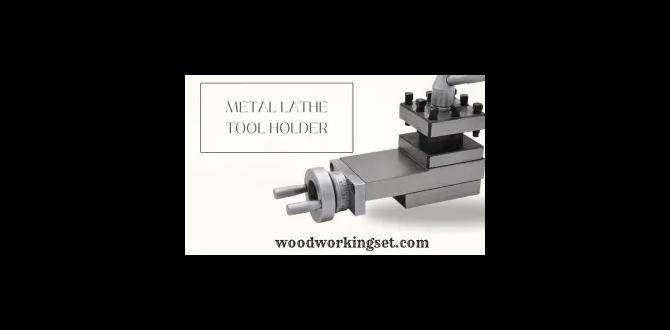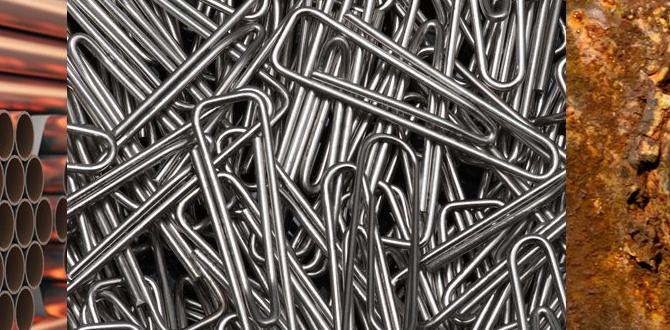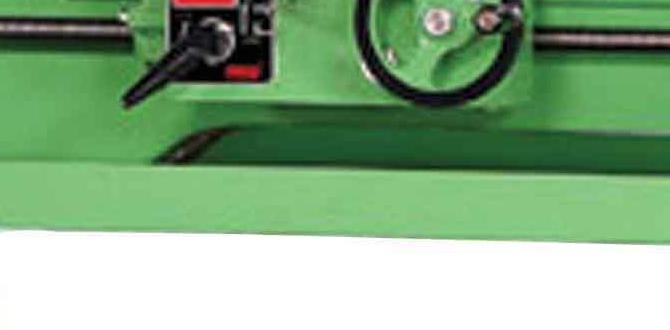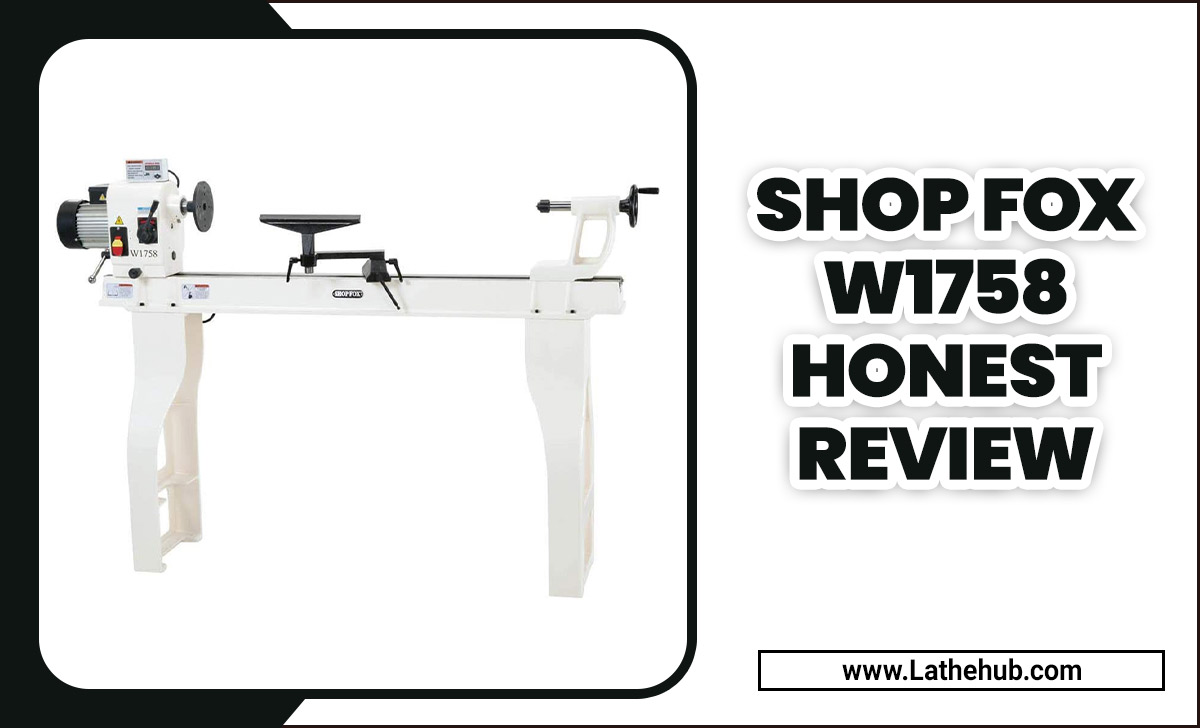A wood lathe with a reverse switch is crucial for many woodworking tasks, allowing for easier sanding, chuck removal, and left-handed turning. This buying guide simplifies choosing the right model, ensuring you get a safe, versatile lathe that enhances your projects and confidence.
Ever found yourself wrestling with a piece of wood on your lathe, wishing you could just spin it the other way to get that perfect finish? You’re not alone! Many beginner woodturners run into this challenge. A standard lathe spins in one direction, which is fine for basic turning, but gets tricky when you need to sand those tricky spots or remove a stubborn chuck. That’s where a wood lathe with a reverse switch comes in. It’s a simple feature, but it makes a huge difference in your workflow and the quality of your finished pieces. Don’t worry if it sounds complicated; I’m Daniel Bates, and at Lathe Hub, I love breaking down these essential tools for you. We’ll walk through exactly what to look for so you can pick the perfect lathe with confidence. Stick around, and we’ll get you turning smoothly in no time!
Why a Reverse Switch Matters on Your Wood Lathe
As a woodturner, you’ll quickly discover that while your lathe spins one way, sometimes the best way to work is the opposite. A wood lathe with a reverse switch isn’t just a fancy add-on; it’s a genuinely useful feature that can significantly improve your turning experience, especially for beginners. It opens up new techniques and makes common tasks much easier and safer.
Sanding Made Simple
Sanding is a critical step in achieving a beautiful finish on your turned projects. When sanding with the grain, you typically want the wood to move away from you. However, some areas, especially on bowls or intricate shapes, are hard to reach effectively with standard forward rotation. With a reverse switch, you can spin the wood backward for easier access to these areas, allowing sandpaper to move in the same direction as the wood fibers. This leads to a smoother, scratch-free surface and reduces the chance of catching your sandpaper, which can cause gouges.
Easier Chuck and Faceplate Removal
Anyone who’s spent time at the lathe has probably experienced a jam-up when trying to remove a chuck or faceplate. Sometimes, the natural direction of the spindle can tighten these accessories further onto the machine, making them incredibly difficult to unscrew. A reverse switch allows you to gently nudge the spindle in the opposite direction, often loosening the grip enough to unscrew them by hand without excessive force or the need for specialized tools. This is a huge win for safety and convenience.
Improved Bowl Turning and Hollowing
When turning the outside of a bowl or hollowing out the inside, you often need to get very close to where the wood attaches to the faceplate or chuck. Working in reverse can give you a much clearer view and better access to these crucial areas. It allows you to scrape or sand right up to the edge without the tool rest or your hands being in awkward positions. For beginners, better visibility and easier access mean greater control and fewer mistakes.
Comfort and Ergonomics
For some individuals, particularly those who might have physical limitations or are left-handed, turning in the standard forward direction can be less comfortable or even physically challenging. A reverse switch provides the flexibility to adapt the lathe’s operation to your personal needs and preferences, ensuring a more comfortable and sustainable turning practice.
Versatility for Advanced Techniques
As you progress in your woodworking journey, you might want to explore more advanced techniques like eccentric turning, off-center turning, or the creation of complex multifaceted objects. Many of these methods benefit greatly from the ability to reverse the direction of spindle rotation. Having this feature from the start means your lathe can grow with your skills.
Key Features to Look for in a Wood Lathe with a Reverse Switch
When shopping for a wood lathe that includes a reverse switch, several other features are equally important to consider. The reverse function is a great start, but balancing it with power, size, and ease of use will ensure you get a tool that truly serves your needs. Let’s break down what makes a good lathe.
Motor Power and Speed Control
The motor is the heart of your lathe. For beginners, a motor in the range of ½ to 1 horsepower is usually sufficient for most turning tasks, from small spindles to medium-sized bowls. More powerful motors (1.5 HP and above) are great for larger projects and tougher woods but can be overkill for simpler work and might require more robust electrical setups. Look for lathes with variable speed control. This is often achieved with a belt-drive system that allows you to shift belts to different pulley positions, or more advanced electronic variable speed (EVS).
- Belt Drive Pulleys: Offers a simpler, often more robust, system. Typically has 3-5 speed settings.
- Electronic Variable Speed (EVS): Provides a wider, smoother range of speeds, often with digital readouts. This is generally more convenient and precise.
The ability to easily adjust speed is crucial because different woods and different turning operations (like roughing out a blank versus fine sanding) require different RPMs. Lower speeds (RPM) are safer for starting, rough shaping, and certain types of sanding, while higher speeds are better for finishing and smaller spindles.
Swing and Distance Between Centers
These two measurements define the maximum size of the workpiece your lathe can handle.
- Swing: This is the maximum diameter of a workpiece that can be rotated over the lathe bed. It’s measured from the spindle centerline to the nearest point on the lathe bed. A larger swing means you can turn bigger bowls or platters.
- Distance Between Centers (or Bed Length): This is the maximum length of a workpiece that can be mounted between the headstock and tailstock centers.
For beginners, a lathe with a swing of 10-12 inches and a distance between centers of around 16-18 inches is a good starting point. This size accommodates a decent range of common projects, from pens and small bowls to small-to-medium table legs. If you plan on making large bowls or long, slender pieces, you’ll need to look for lathes with larger swing capacities and longer beds.
Bed Construction and Stability
A stable lathe is a safe lathe. The bed of the lathe provides the foundation for the tool rest and tailstock, so its rigidity is paramount. Cast iron beds are generally preferred over steel or aluminum for their mass and vibration-damping qualities. Look for a lathe that feels solid and sturdy. If possible, try to feel its weight; heavier machines tend to vibrate less, leading to smoother cuts and a better finish.
Tool Rest and Tailstock Design
The tool rest needs to be easily adjustable and securely lock in place. Most entry-level to mid-range lathes use a basic post and clamp system. Higher-end models might offer banjo-style mounts for smoother movement. Ensure the tool rest holder and the tailstock quill lock tightly so they don’t shift during operation. The tailstock should also offer enough travel to accommodate various workpiece lengths and enable drilling operations.
Reverse Switch Type and Location
When it comes to the reverse switch itself, consider its type and where it’s located. Some lathes have a dedicated toggle switch that’s easily accessible during operation. Others might have a knob you turn. The key is that it should be intuitive to find and use without having to break your concentration. It should also be positioned safely, away from where your hands would naturally be while turning but close enough for quick access if needed.
Ease of Speed Changes
As mentioned, variable speed is vital. But how easy is it to change the speed? Belt-driven lathes require you to open a motor access panel, loosen a belt tensioner, move the belt to a different pulley combination, and then re-tension the belt. While this is effective, it can be time-consuming. Electronic variable speed (EVS) lathes allow for quick adjustments on the fly, which is a significant convenience, especially when you’re constantly seeking that perfect RPM.
Included Accessories and Upgradability
Most starter lathes come with essential accessories like a faceplate, a spur drive center, a live tailstock center, and a basic tool rest. Check what’s included. Also, consider if the lathe has common mounting threads (like 1 x 8 TPI, which is standard in North America) for chucks and other accessories. The ability to upgrade to a better chuck, a different tool rest system, or even add an extension bed later can extend the life and capability of your investment.
Comparing Lathe Types: Reverse Switch Availability
Not all wood lathes are created equal, and the presence of a reverse switch can vary significantly between different types and price points. Understanding these differences will help you make an informed decision.
| Lathe Type | Typical Motor Size | Variable Speed | Reverse Switch | Beginner Suitability | Pros | Cons |
|---|---|---|---|---|---|---|
| Benchtop Lathes | 1/2 HP – 3/4 HP | Often Limited (Belt Adj.) | Less Common | Very Good | Compact, affordable, easy setup | Limited swing/distance, less power, may lack reverse |
| Midi Lathes | 3/4 HP – 1 HP | Common (Belt Adj. or EVS) | Becoming More Common | Excellent | Good balance of size/power, often good value | May still be limited for very large projects |
| Full-Size/Larger Lathes | 1 HP – 3+ HP | Very Common (EVS or Belt Adj.) | Very Common | Good, if chosen carefully | Ample power, capacity, advanced features | Larger footprint, higher cost, can be overkill for beginners |
Benchtop Lathes
These are the smallest and most affordable lathes, designed to sit on a workbench. They are fantastic for pen turning, small decorative items, and learning the basics. However, many very basic benchtop models do not come with a reverse switch, prioritizing cost and simplicity. If a reverse switch is a must-have for you, you’ll need to scrutinize the specifications carefully or look at slightly more advanced benchtop models.
Midi Lathes
Midi lathes offer a step up in size and power from benchtop models. They are incredibly popular with hobbyists and intermediate woodturners. This is often where you start seeing the reverse switch feature become more prevalent. Many midi lathes, especially those with electronic variable speed, include a reverse function as a standard or optional feature. Their balance of size, power, and price makes them an excellent choice for many beginners who want a capable machine from the start.
Full-Size and Industrial Lathes
These are the larger, more powerful machines designed for serious hobbyists and professionals turning large bowls, furniture components, or working with dense hardwoods. At this level, a reverse switch is almost always a standard feature, often accompanied by more sophisticated speed control and greater overall capacity. While these are the most capable machines, their size and cost can be prohibitive for beginners, and the reverse switch, while present, is just one of many advanced features.
How to Safely Use a Wood Lathe with a Reverse Switch
Safety is always the top priority in any workshop, and using a tool with added functionality like a reverse switch requires a mindful approach. While the reverse function makes many tasks easier, always remember that a spinning piece of wood can be dangerous. Adhering to best practices will ensure you stay safe and enjoy your turning sessions.
Read Your Manual
This cannot be stressed enough. Every lathe is slightly different. Your owner’s manual will detail the specific operation of your lathe’s reverse switch, any safety interlocks, and maintenance procedures. Familiarize yourself with it thoroughly before your first turning session.
Wear Appropriate Safety Gear
Always wear a safety glasses or a full face shield. A dust mask or respirator is also recommended, especially when sanding. Loose clothing, jewelry, and long hair should be secured or removed, as they can easily get caught in the rotating machinery.
Secure Your Workpiece Properly
Before turning on the lathe, ensure your workpiece is securely mounted between the headstock and tailstock, or on a chuck or faceplate that is tightly fastened to the spindle. Wobbly workpieces are a primary cause of accidents.
Start Slow and Increase Speed Gradually
When you start turning a new piece or after making significant changes, always begin at the lowest speed setting. Gradually increase the speed as you confirm the workpiece is balanced and running true. If you hear any unusual noises or vibrations, stop the lathe immediately and check your setup.
Understand When to Use Reverse
Use the reverse function judiciously. It’s ideal for tasks like sanding, polishing, and removing chucks. Avoid using it for heavy roughing or shaping operations, especially with tools that are not designed for reverse cutting. Some tools, particularly certain types of scrapers, can be dangerous if used in reverse, as they’re designed to cut in a specific direction. Always assess the tool and the operation before engaging reverse.
Be Aware of Tool Rest Placement
Ensure your tool rest is positioned correctly and securely locked. It should be close to the workpiece (about the diameter of a pencil away) but not touching it. The cutting edge of your tool should swivel into the wood from the rest. When using reverse, you might need to adjust the tool rest position to maintain optimal clearance and support.
Know How to Stop Quickly
Familiarize yourself with the location of the power switch or emergency stop button. In case of any issue, you need to be able to shut down the lathe instantly. Practice reaching for it without looking.
Inspect Your Tools
Ensure your turning tools are sharp and in good condition. Dull tools require more force, increase the risk of catches, and produce a poorer finish. Keep your tools organized and stored safely when not in use.
Common Woodworking Tasks Enhanced by a Reverse Switch
Let’s dive into some specific woodworking tasks that become significantly easier and more effective when you have a wood lathe with a reverse switch at your disposal.
Sanding and Finishing
This is probably the most common and appreciated use of the reverse function among woodturners.
- Improving Surface Finish: To achieve a perfectly smooth surface, especially on bowls and hollow forms, sanding in the reverse direction can be incredibly beneficial. It allows you to sand “downhill” on the curve, helping to pull the sandpaper across the surface rather than pushing it, which reduces the risk of sanding induced tear-out or fuzzies.
- Reaching Awkward Spots: Especially when working on the bottom of a bowl or the interior of deep hollow forms, reversing the direction can make it much easier to get sandpaper into those tight areas without awkward hand positions or the need for specialized sanding attachments.
- Dealing with Grain Reversals: Hardwoods with complex grain patterns can sometimes result in fuzzy surfaces when sanding in the standard direction. Reversing the lathe can help to “burnish” or smooth these areas more effectively.
Chuck and Faceplate Removal
As mentioned before, this is a huge safety and convenience feature.
- Breaking the “Friction Weld”: When a chuck or faceplate has been subjected to the forces of turning, it can sometimes feel as though it has become fused to the spindle. A gentle nudge in reverse, often just a few degrees, can break this friction weld, making it much easier to unscrew by hand.
- Avoiding Straining: Without reverse, you might resort to hammering or using excessive force, which is dangerous. The reverse function allows for a controlled loosening of the threads.
Hollowing Bowls and Hollow Forms
When turning the outside of a bowl, you’re working from the rim down to the base. When you flip it around to hollow the inside, you’re working from the rim inwards.
- Better Visibility and Control: Reversing the lathe allows you to see your tool engage the wood from a different angle, which can be helpful when hollowing out deep forms. You can get closer to the chuck or remaining waste material with better sightlines.
- Scraping with Confidence: Hollowing often involves scrapers. While scrapers can be used in both directions, using them in reverse can sometimes offer a different feel or finish depending on the tool’s bevel.
Working with Specific Tools
Some turning tools perform differently or are intended for specific directions of cut.
- Detail Tools: Certain fine detail tools or specialized scrapers might be designed for optimal performance in reverse.
- Diamond Coated Sanding Discs: These discs are excellent for smoothing end grain and can sometimes be used more effectively in reverse.
It’s important to note that while a reverse switch offers great benefits, it’s not a magic bullet for all turning problems. Always use sharp tools and understand their proper application. The biggest advantage is the added flexibility it gives you in your turning process.
Tips for Buying Your First Wood Lathe with a Reverse Switch
Stepping into the world of

